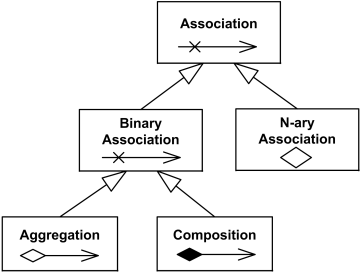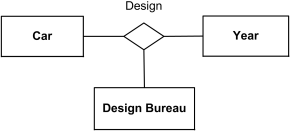UML Association Reference
| Notation | Description |
|---|---|
| Association | |

Association Wrote between Professor and Book with association ends author and textbook. |
Association is a relationship between classifiers which is used to show that instances of classifiers could be either linked to each other or combined logically or physically into some aggregation. An association is usually drawn as a solid line connecting two classifiers or a single classifier to itself. Name of the association can be shown somewhere near the middle of the association line but not too close to any of the ends of the line. Each end of the line could be decorated with the name of the association end. |

Association relationship overview diagram |
|

|
Binary association relates two typed instances. It is normally rendered as a solid line connecting two classifiers, or a solid line connecting a single classifier to itself (the two ends are distinct). The line may consist of one or more connected segments. |

Order of the ends and reading: Car - was designed in - Year |
A small solid triangle could be placed next to or in place of the name of binary association (drawn as a solid line) to show the order of the ends of the association. The arrow points along the line in the direction of the last end in the order of the association ends. This notation also indicates that the association is to be read from the first end to the last end. |

Ternary association Design relating three classifiers. |
Any association may be drawn as a diamond (larger than a terminator on a line) with a solid line for each association end connecting the diamond to the classifier that is the end’s type. N-ary association with more than two ends can only be drawn this way. |
| Aggregation | |

Search Service has a Query Builder using shared aggregation |
Aggregation (aka shared aggregation) is shown as binary association decorated with a hollow diamond as a terminal adornment at the aggregate end of the association line. |
| Composite Aggregation (Composition) | |

Folder could contain many files, while each File has exactly one Folder parent. If Folder is deleted, all contained Files are deleted as well. |
Composite aggregation (aka composition) is a "strong" form of aggregation. Composition requirements/features listed in UML specification are:
Composition is depicted as binary association decorated with a filled black diamond at the aggregate (composite) end. |
|
Hospital has 1 or more Departments, and each Department belongs to exactly one Hospital. |
When composition is used in domain models, both whole/part relationship as well as event of composite "deletion" should be interpreted figuratively, not necessarily as physical containment and/or termination. |
|
Each Department has some Staff, and each Staff could be a member of one Department (or none). If Department is closed, its Staff is relieved (but excluding the "stand alone" Staff). |
Multiplicity of the composite (whole) could be specified as 0..1 ("at most one") which means that part is allowed to be a "stand alone", not owned by any specific composite. |
| Ownership of Association End | |

Association end query is owned by classifier QueryBuilder and association end qbuilder is owned by association Builds itself. |
Ownership of association ends by an associated classifier may be indicated graphically by a small filled circle (aka dot). The dot is drawn at the point where line meets the classifier. It could be interpreted as showing that the model includes a property of the type represented by the classifier touched by the dot. This property is owned by the classifier at the other end. |

Association end qb is an attribute of SearchService class and is owned by the class. |
Attribute notation can be used for an association end owned by a class, because an association
end owned by a class is also an attribute.
This notation may be used in conjunction with the line arrow notation to make
it perfectly clear that the attribute is also an association end.
|
| Association Navigability | |

Both ends of association have unspecified navigability. |
No adornment on the end of an association means unspecified navigability.
|

A2 has unspecified navigability while B2 is navigable from A2. |
Navigable end is indicated by an open arrowhead on the end of an association.
|

A3 is not navigable from B3 while B3 has unspecified navigability. |
Not navigable end is indicated with a small x on the end of an association.
|

A4 is not navigable from B4 while B4 is navigable from A4. |
|

A5 is navigable from B5 and B5 is navigable from A5. |
|

A6 is not navigable from B6 and B6 is not navigable from A6. |
|
| Link | |

Link Wrote between instance p of Professor
playing author role |
Link is an instance of an association. It is rendered using the same notation as for an association. Solid line connects instances rather than classifiers. Name of the link could be shown underlined though it is not required. End names (roles) and navigation arrows can be shown. |